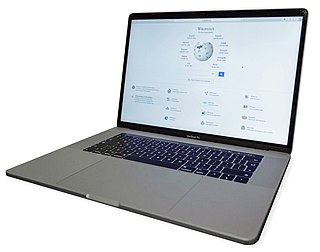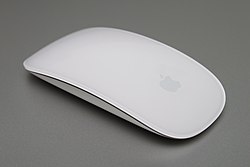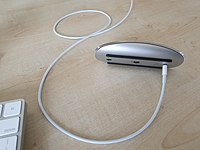
A touchpad or trackpad is a type of pointing device. Its largest component is a tactile sensor: an electronic device with a flat surface, that detects the motion and position of a user's fingers, and translates them to a position on a screen, to control a pointer in a graphical user interface. Touchpads are common on laptop computers, contrasted with desktop computers, where mice are more prevalent. Trackpads are sometimes used on desktops, where desk space is scarce. Because trackpads can be made small, they can be found on personal digital assistants (PDAs) and some portable media players. Wireless touchpads are also available, as detached accessories.

Mission Control is a feature of the macOS operating system. Dashboard, Exposé, and Spaces were combined and renamed Mission Control in 2011 with the release of Mac OS X 10.7 Lion. Exposé was first previewed on June 23, 2003, at the Apple Worldwide Developers Conference as a feature of the then forthcoming Mac OS X 10.3 Panther.

VoiceOver is a screen reader built into Apple Inc.'s macOS, iOS, tvOS, watchOS, and iPod operating systems. By using VoiceOver, the user can access their Macintosh or iOS device based on spoken descriptions and, in the case of the Mac, the keyboard. The feature is designed to increase accessibility for blind and low-vision users, as well as for users with dyslexia.

The Apple Mouse is a multi-control USB mouse manufactured by Mitsumi Electric and sold by Apple Inc. It was announced and sold for the first time on August 2, 2005, and a Bluetooth version was available from 2006 to 2009. Before the Mighty Mouse, Apple had sold only one-button mice with its computers, beginning with the Apple Lisa 22 years earlier. The Mighty Mouse supported two buttons, and a miniature trackball for scrolling.

Apple Inc. has designed and developed many external keyboard models for use with families of Apple computers, such as the Apple II, Mac, and iPad. The Magic Keyboard and Magic Keyboard with Numeric Keypad designed to be used via either Bluetooth and USB connectivity, and have integrated rechargeable batteries; The Smart Keyboard and Magic Keyboard accessories for iPads are designed to be directly attached to and powered by a host iPad. All current Apple keyboards utilize low-profile key designs, and common modifier keys.

The Apple Wireless Keyboard is a wireless keyboard built for Macintosh computers and compatible with iOS devices. It interacts over Bluetooth wireless technology and unlike its wired version, it has no USB connectors or ports. Both generations have low-power features when not in use. It was discontinued on October 13, 2015, and was succeeded by the new Magic Keyboard.

The MacBook Pro is a line of Mac laptops made by Apple Inc. Introduced in January 2006, it is the higher-end lineup in the MacBook family, sitting above the consumer-focused MacBook Air. It is currently sold with 14-inch and 16-inch screens, all using Apple silicon M-series chips.

The MacBook is a brand of Mac notebook computers designed and marketed by Apple Inc. that use Apple's macOS operating system since 2006. It replaced the PowerBook and iBook brands during the Mac transition to Intel processors, announced in 2005. The current lineup consists of the MacBook Air (2008–present) and the MacBook Pro (2006–present). Two different lines simply named "MacBook" existed from 2006 to 2012 and 2015 to 2019. The MacBook brand was the "world's top-selling line of premium laptops" as of 2015.

Apple Inc. has designed and manufactured several models of mice, trackpads, and other pointing devices, primarily for use with Macintosh computers. Over the years, Apple has maintained a distinct form and function with its mice that reflect their design languages of that time. Apple's current external pointing devices are the Magic Mouse 2 and Magic Trackpad 2.

Apple Inc. has produced and sold headphones since 2001, available for standalone purchase and bundled with iPhone and iPod products. Apple's current product line consists of EarPods, AirPods and AirPods Pro, and AirPods Max.

The Magic Trackpad is a multi-touch trackpad produced by Apple Inc. The first generation version was released on July 27, 2010, and featured a trackpad 80% larger than the built-in trackpad found on the then-current MacBook family of laptops. A redesigned second generation version, initially marketed as Magic Trackpad 2, was released on October 13, 2015.

The Apple Battery Charger is a battery charger which was sold by Apple Inc. and bundled with six AA batteries. It was introduced in July 2010 and marketed as a way to charge Apple's wireless Magic Mouse, Magic Trackpad and Apple Wireless Keyboard. The charger was discontinued around 2016, after Apple revised their peripherals with built-in batteries that can be charged with a Lightning connector.

Lightning is a proprietary computer bus and power connector, created and designed by Apple Inc. It was introduced on September 12, 2012, in conjunction with the iPhone 5, to replace its predecessor, the 30-pin dock connector. The Lightning connector is used to connect Apple mobile devices like iPhones, iPads, and iPods to host computers, external monitors, cameras, USB battery chargers, and other peripherals. Using 8 pins instead of 30, Lightning is much smaller than its predecessor. The Lightning connector is reversible. The plug is indented on each side to match up with corresponding points inside the receptacle to retain the connection.

The 12-inch MacBook is a discontinued Mac laptop made by Apple Inc., which sat between the MacBook Air and MacBook Pro in Apple's laptop lineup.

The iPad Pro is a series of tablet computers, positioned as a premium model of Apple's iPad tablet computer. It runs iPadOS, a tablet-optimized version of the iOS operating system.
Apple Pencil is a line of wireless stylus pen accessories designed and developed by Apple Inc. for use with supported iPad tablets.

The Siri Remote is a remote control released by Apple with the Siri-capable fourth generation and later Apple TV. The Siri Remote is the successor to the original Apple Remote.

The Magic Keyboard is a family of wireless computer keyboards manufactured by Foxconn under contract for Apple Inc. The keyboards are bundled with the iMac and Mac Pro, and also sold as standalone accessories. They replaced the Apple Wireless Keyboard product line. Each Magic Keyboard model combination has a compact or full-size key layout for a specific region, a function key or Touch ID sensor next to F12, and color scheme variant.

The Intel-based MacBook Pro is a discontinued line of Macintosh notebook computers sold by Apple Inc. from 2006 to 2021. It was the higher-end model of the MacBook family, sitting above the consumer-focused MacBook Air, and was sold with 13-inch to 17-inch screens.

The sixth-generation iPad Pro, colloquially known as the M2iPad Pro, is a line of iPad tablet computers developed and marketed by Apple Inc. It was announced on October 18, 2022, and was released on October 26, 2022. It is available with the same screen size options as its predecessor: 11-inch and 12.9-inch.



















